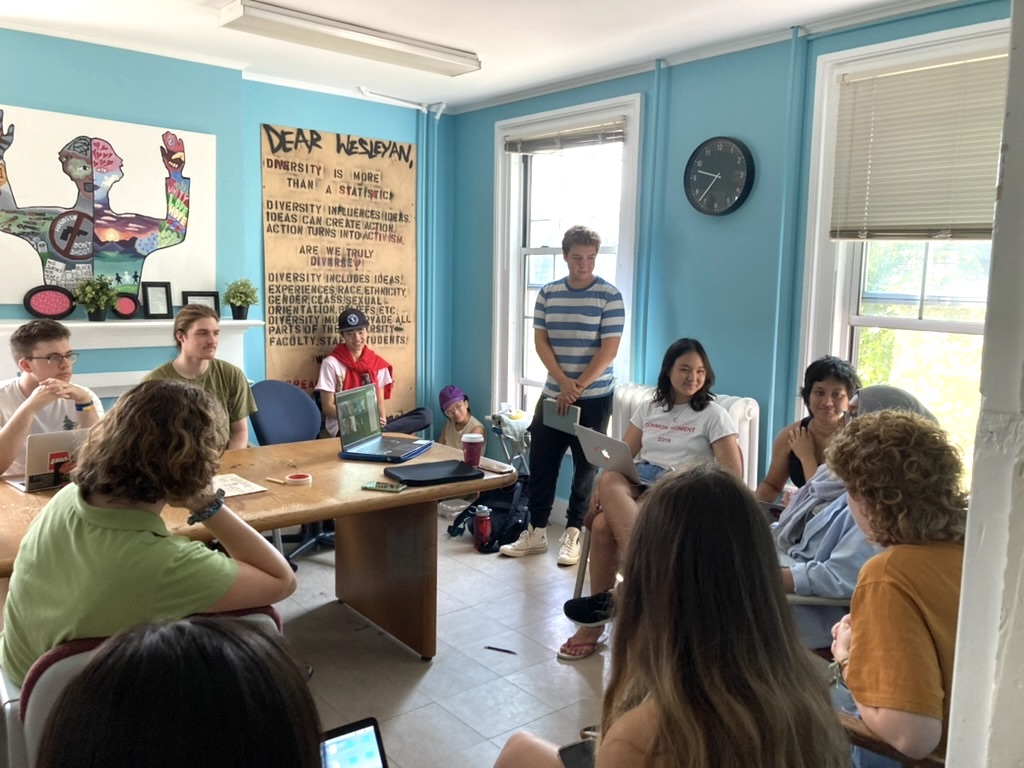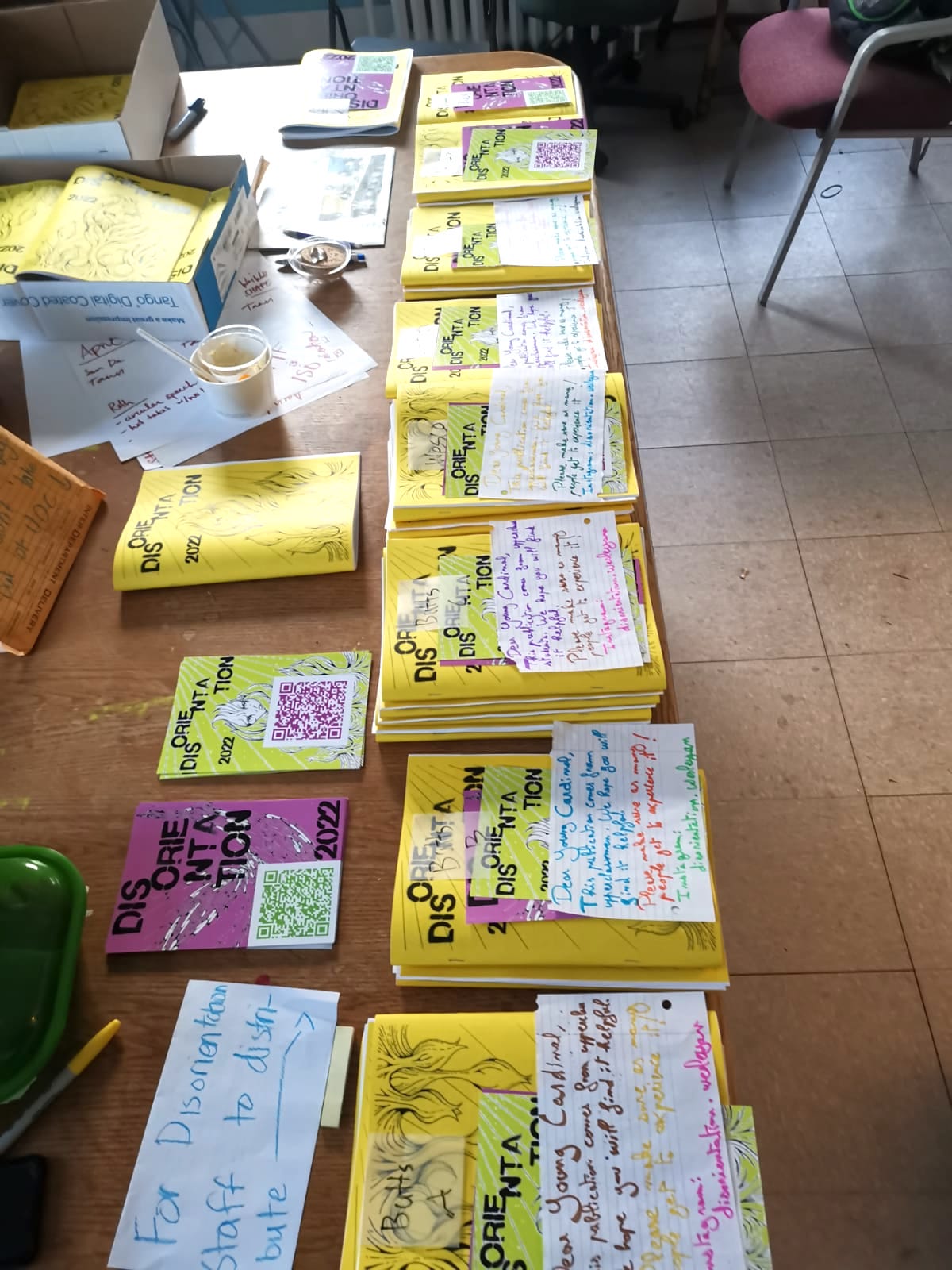
c/o Heather Cassell
Disorientation, a student-run zine that aims to supplement first-year orientation with candid takes on life at the University, has returned after five years without publishing. The zine features timelines of University history, descriptions of campus culture and institutions, and student experiences, all intended to showcase the best and worst parts of life at the University.
“This publication is characterized by constructive criticism intended to consolidate information regarding [the University]’s tradition of student activism, stimulate our present collective dialogue and action, and ultimately overcome the institutionalized discrimination, barriers, and limits which persist at this university,” the zine’s opening description states.
First created in the 1970s, Disorientation offers itself as a handbook for navigating aspects of life on campus that members of the University community don’t necessarily talk about. Articles in Disorientation 2022 include topics such as power hierarchies in the University’s administration, party and hook-up culture, eating disorders in college, religious life, student activism, on-campus sustainability, and issues pertaining to FGLI students, students of color, international students, and LGBTQ students, among many other subjects.
“After a series of conversations that took place in Spring 2022, we realized that discussions about issues at Wes were very siloed off and because of that it’s really hard to create change,” Richard Bennet ’23 wrote in an email to The Argus. “Especially, coming out of the more isolating phases of the pandemic we realized the dangers of losing institutional memory. Since the class of 2023 is the last class to have experienced pre-covid Wes, there was also a desire to avoid total loss of traditions and culture at [the University].”
After these discussions about bringing back Disorientation, a group of interested students spent the summer planning and recruiting before starting the writing and compilation process in the fall. The zine officially came out on Thursday, Nov. 3.
Sumaiya Sabnam ’23, who participated in the efforts to bring back Disorientation, explained that the organizers realized many students on campus do not know the ins and outs of how the University works and how these factors affect students, thus inspiring the publication’s intention to rectify this
“All the issues in Disorientation were what students and writers thought should be included and important for other students to know,” Sabnam wrote in an email to The Argus. “There were more things we wanted to add but if we added everything it would have been more than 100 pages long.”
Robyn Wong ’23, another Disorientation organizer and contributor, emphasized that one goal of the publication was to feature a range of articles about campus culture, politics, and resources.

c/o Disorientation
“There are some pieces of information, such as the activism timeline, that have historically been in Disorientation that we wanted to keep in the 2022 edition,” Wong wrote in an email to The Argus. “We also wanted to include essential information we thought students should know (e.g. how the administration is structured at [the University]), as well as pieces that felt particularly timely to [the University]’s present moment (e.g. ResLife article and labor activism on campus). The articles are aligned in that while they often critique the institution, [but] we made a concerted effort to ensure that this critique was productive.”
The publication’s reach spread beyond students to staff and faculty. Assistant Professor of History Jeffers Lennox expressed that Disorientation helps members of the community find ways to build meaningful connections and organize across the entire campus.
“It is crucial that students build solidarity amongst themselves—and, when possible, in partnership with staff and faculty—in ways that ensure those most vulnerable on campus can find support and push for changes that will benefit the entire [University] community,” Lennox wrote in an email to The Argus.
Similarly to Lennox, Marcus Khoo ’23, a member of Disorientation, thinks that the zine holds the potential to bridge the gap between students and faculty/staff in a new way.
“A whole lot of people aren’t happy with the way things are run here, be it faculty, staff, or even administrators, and they’ve been thinking and organizing around these issues,” Khoo wrote in an email to The Argus. “I have a feeling a lot of our grievances are pretty similar and interrelated….We need to engage other constituencies of the University in order to reclaim and redefine what we’re doing here….and Disorientation is an indication from the student side that we are here and we deserve a seat at the table.”
Disorientation guides have a long history on college campuses. President Michael Roth ’78 recalled reading Disorientation in the 1970s while he was a student here.
“I couldn’t be more excited [about the return of Disorientation],” Roth said. “I remember it pretty vividly because I remember how cool I thought it was, sitting in my dorm on Foss Hill there, and getting Disorientation 1975…. Somebody gave it to me at homecoming [this year], and I thought, wow, it’s back. And there I am in the middle of it, oh shit.”
The first step in reviving Disorientation was finding students interested in contributing to the zine. Bennet explained that the recruitment process proved to be more complicated than expected. The initial group worked hard to garner more interest through word of mouth and WesAdmits.
“Since we relied a lot on people telling their friends, it was a bit hard to reach certain groups on campus we wanted to work with,” Bennet wrote. “We really wanted to publish around the beginning of the semester but recruitment came in waves which made it hard to coordinate at times. We have learned a lot from this experience and will be making good use of all that knowledge to make the recruitment process for the next edition less stressful and hurried.”
Disorientation hopes to gain more members to take part in the planning and writing process for next year’s edition. The group held an open forum for students to learn about the project and share their thoughts.
“It’s important for us to open the space where everyone can come together and talk about it and potentially to do something to change it,” Sabman wrote.
Charissa Lee ’23 wrote pieces on hook-up culture and religious life for the zine and emphasized the importance of Disorientation on campus.
“We brought it back because everyone needs to know the full spectrum of issues on this campus, and who to go to advocate for the solutions,” Lee wrote in an email to The Argus. “A lack of clearly defined Wesleyan identity has allowed for a lot of vagueness and therefore an opportunity for exploitation and failure.”
Students around campus reveled in the arrival of Disorientation as a way of spreading and preserving institutional knowledge about what the University was like before the COVID-19 pandemic, especially in terms of traditions that may not have continued.
“Many students including myself are largely uninformed about the [inner workings] of school institutions and the student experience,” AJ Minzer ’25 wrote in a message to The Argus. “I was just blown away by the stories that seem largely swept under the rug. I hope that Disorientation will continue, and have an impact on the resurgence of traditions and student organizing.”
The Disorientation team has much they hope to accomplish going forward, including the launch of a website, the creation of a succession plan for when its many seniors graduate, and the institutionalization of a space for dialogue between students, faculty, and staff dialogue. Bennet elaborated on aspects of the zine that the team hopes to expand.
“We will be working in the spring to make a better plan for outreach and coverage of important issues,” Bennet wrote. “We can never cover everything, but some perspectives that are usually in Disorientation could be brought back. I would also like to feature more student art in the zine. One thing I really liked about older versions is that the tone and aesthetics of the zine really seemed to be reflective of the culture at Wes. Our community being so artistically driven in multiple ways, I would like to expand that going forward.”
Wong echoed Bennet’s sentiments, stressing the importance of continuing to incorporate new perspectives.
“Going forward, we hope to ride the wave of this refreshed discourse to build greater solidarity between what has thus far been extremely siloed parts of [the University],” Wong said. “What we noticed was that in as much as the articles were talking about extremely different topics (administrative, faculty, student experiences) there are common themes that cut across them (e.g. identity crisis, resource misallocation, lack of information). How can we come together to build communities and solutions to these issues?”
For students looking to learn more about Disorientation, follow @disorientation.wes on Instagram.
Gabby McIntosh contributed to reporting and can be reached at gmcintosh@wesleyan.edu.
Elias Mansell contributed to reporting and can be reached at emansell@wesleyan.edu.
Rachel Wachman can be reached at rwachman@wesleyan.edu.
Comments are closed